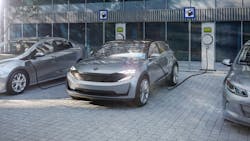"Electrify everything" is the new rallying cry in the energy industry. Electricity already powers the American economy, but in the coming decades that reliance on energy will escalate. Electrification — from transportation to heating — is sure to increase energy demand in the short run and reshape our industry and society in the long-term.
Electrification of sectors currently powered by fossil fuels is about to cause more than just a ripple in the energy pool. It is bound to cause a near tidal-wave, and the energy sector needs to be prepared for it if it is going to continue to be a reliable and affordable provider of energy.
An array of factors — energy efficiency appliance standards, building codes — has helped keep electricity demand flat for more than a decade; in 2018, that changed. The Energy Administration Agency announced recently that energy use jumped 4% in the last year. That may be just the beginning.
The future generation and use of energy and electricity must be at the forefront of the minds of policymakers and citizens alike. Concerns about the climate impacts of burning fossil fuels are causing them to consider and encourage development of low-carbon energy sources to power homes, businesses, industry, and transportation.
How do we know that electricity demand is poised to increase? Right now there are more than 1 million electric vehicles (EVs) on the road in the United States. According to the Edison Electric Institute, there will be as many as 7 million by 2025 and 18 million by 2030. This entails not just the four-door family sedan, but pickups, semi-trucks, vans, and more.
On top of the electrification of the transportation sector, the heating and cooling of homes and businesses through electric heat pumps is also expected to increase electricity demand in the coming years.
The Brattle Group, in a report prepared for WIRES, the transmission industry association, estimated that energy demand could jump as much as a whopping 85% by 2050.
Such a burst of new energy demand will place new strain on an aging transmission infrastructure system, much of which dates to the 50s, 60s, and 70s.
Ensuring a reliable and modernized and future-proof electricity system is critical to delivering energy to customers. Whether it is connecting new offshore wind generators, facilitating the expansion of distributed solar, or supporting cooperation across regional boundaries, electric transmission is the vital link between customers and keeping the lights on.
Meanwhile, the nation’s electric supply portfolio is in flux: Aging and inefficient coal plants are retiring; renewable generation is growing significantly. The Brattle Group predicts that these changes, combined with the anticipated increases in electricity demand, will drive the development of as much as 200 GW of new power generation — the amount needed to power more than 70 million homes — by 2030 alone — and as many as 800 GW by 2050.
The changes mean that there will be a lot of new energy resources — utility-scale wind and solar projects, among others — being built in remote parts of the country. Without enhanced, state-of-the-art transmission networks, there is a chance those new resources could be stranded and the clean energy generated might not be delivered to load centers in our major cities.
The Brattle Group estimates that incremental investments of between US$30 and US$90 billion will be needed in the nation’s transmission network by 2030 — and between $200 billion and $600 billion by 2050. Those are big numbers, but it demonstrates an urgent need for more effective long-term planning to support the rapidly electrifying economy and the new fuel mix.
The extensive transmission needs combined with the long lead times needed to make and implement transmission investments make it clear there are some important next steps to ensure that we meet the electrification needs of the coming 30 years:
- Policymakers must recognize the risks and potentially higher costs to customers associated with permitting changes and development delays.
- Electrification must be part of policymakers’ transmission planning processes — especially in areas where use of EVs is expected to grow rapidly.
- Transmission planners must be mindful of the addition of new renewable generation.
- Transmission planners should continue to expand their consideration of larger scale interregional, and even national-level, projects in their studies.
As a collective industry — and even as a modernized society — we must be prepared for the rapid changes underway in our energy economy, or risk being unprepared to meet customer needs and ensuring system reliability.
As utilities and transmission planning organizations forecast the necessary investment to modernize transmission infrastructure, rapid industry changes and expanded demands on the system must be considered. The electric industry is well-positioned to enable the technological, transportation and heating changes and usher in a clean energy revolution to fight climate change.
We have an opportunity to cost-effectively plan our transmission grid to support electrification. Are we ready to seize the opportunity? It is now time to prepare the change and the technical and economic challenges it will bring.
About the Author
Brian Gemmell
Brian Gemmell is the president of WIRES, the transmission industry trade association, and vice president of Asset Management & Planning at National Grid.
